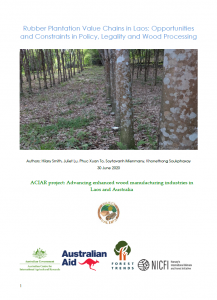Rubber Plantation Value Chains in Laos: Opportunities and Constraints in Policy, Legality and Wood Processing
By Hilary Smith, Juliet Lu, Phuc Xuan To, Soytavanh Mienmany, Khonethong Soukphaxay View PublicationStudies on rubber (Hevea brasiliensis) in the Lao People’s Democratic Republic (Lao PDR, Laos) have largely focussed on land allocation and relations between the Lao State, investors, and Lao rubber farmers. The history and international context, and some environmental and social impacts have been investigated to a lesser extent, and there are no comprehensive studies that consider entire rubber value chains in Laos.
Concerns for the sustainability of natural rubber and rubberwood are rising among manufacturers and consumers, spurring interest in tracing these social and environmental impacts along the commodity chain, as well as product legality. However, there are gaps in knowledge, particularly with respect to rubberwood. This study starts to address these gaps by exploring the four themes of land, labour, latex, and wood. It traces interactions along the rubber value chain, including the role of foreign investors specifically from China and Viet Nam, the top foreign investors in rubber in Laos, the primary market destinations for Lao produced rubber and the likely destinations for rubberwood.

